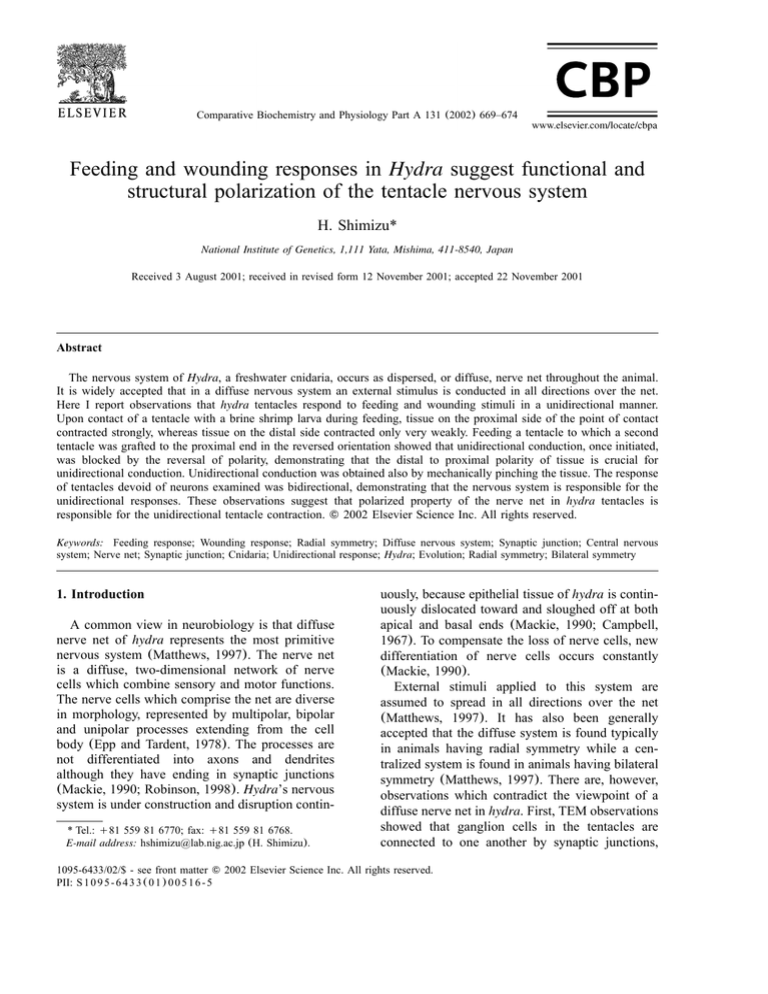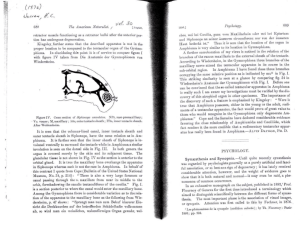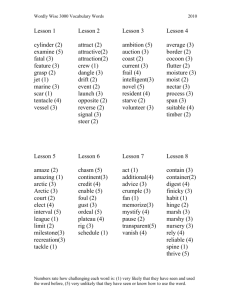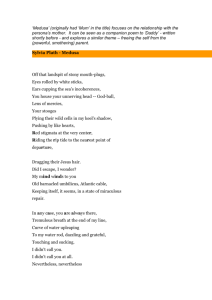
Comparative Biochemistry and Physiology Part A 131 (2002) 669–674
Feeding and wounding responses in Hydra suggest functional and
structural polarization of the tentacle nervous system
H. Shimizu*
National Institute of Genetics, 1,111 Yata, Mishima, 411-8540, Japan
Received 3 August 2001; received in revised form 12 November 2001; accepted 22 November 2001
Abstract
The nervous system of Hydra, a freshwater cnidaria, occurs as dispersed, or diffuse, nerve net throughout the animal.
It is widely accepted that in a diffuse nervous system an external stimulus is conducted in all directions over the net.
Here I report observations that hydra tentacles respond to feeding and wounding stimuli in a unidirectional manner.
Upon contact of a tentacle with a brine shrimp larva during feeding, tissue on the proximal side of the point of contact
contracted strongly, whereas tissue on the distal side contracted only very weakly. Feeding a tentacle to which a second
tentacle was grafted to the proximal end in the reversed orientation showed that unidirectional conduction, once initiated,
was blocked by the reversal of polarity, demonstrating that the distal to proximal polarity of tissue is crucial for
unidirectional conduction. Unidirectional conduction was obtained also by mechanically pinching the tissue. The response
of tentacles devoid of neurons examined was bidirectional, demonstrating that the nervous system is responsible for the
unidirectional responses. These observations suggest that polarized property of the nerve net in hydra tentacles is
responsible for the unidirectional tentacle contraction. 䊚 2002 Elsevier Science Inc. All rights reserved.
Keywords: Feeding response; Wounding response; Radial symmetry; Diffuse nervous system; Synaptic junction; Central nervous
system; Nerve net; Synaptic junction; Cnidaria; Unidirectional response; Hydra; Evolution; Radial symmetry; Bilateral symmetry
1. Introduction
A common view in neurobiology is that diffuse
nerve net of hydra represents the most primitive
nervous system (Matthews, 1997). The nerve net
is a diffuse, two-dimensional network of nerve
cells which combine sensory and motor functions.
The nerve cells which comprise the net are diverse
in morphology, represented by multipolar, bipolar
and unipolar processes extending from the cell
body (Epp and Tardent, 1978). The processes are
not differentiated into axons and dendrites
although they have ending in synaptic junctions
(Mackie, 1990; Robinson, 1998). Hydra’s nervous
system is under construction and disruption contin* Tel.: q81 559 81 6770; fax: q81 559 81 6768.
E-mail address: hshimizu@lab.nig.ac.jp (H. Shimizu).
uously, because epithelial tissue of hydra is continuously dislocated toward and sloughed off at both
apical and basal ends (Mackie, 1990; Campbell,
1967). To compensate the loss of nerve cells, new
differentiation of nerve cells occurs constantly
(Mackie, 1990).
External stimuli applied to this system are
assumed to spread in all directions over the net
(Matthews, 1997). It has also been generally
accepted that the diffuse system is found typically
in animals having radial symmetry while a centralized system is found in animals having bilateral
symmetry (Matthews, 1997). There are, however,
observations which contradict the viewpoint of a
diffuse nerve net in hydra. First, TEM observations
showed that ganglion cells in the tentacles are
connected to one another by synaptic junctions,
1095-6433/02/$ - see front matter 䊚 2002 Elsevier Science Inc. All rights reserved.
PII: S 1 0 9 5 - 6 4 3 3 Ž 0 1 . 0 0 5 1 6 - 5
670
H. Shimizu / Comparative Biochemistry and Physiology Part A 131 (2002) 669–674
which often have synaptic vesicles only on one
side of the junction, thereby allowing unidirectional conduction of the stimulus between two nerve
cells (Westfall et al., 1971; Westfall, 1996). Second, the morphological observation of nerve cells
showed that there are bipolar but asymmetrically
shaped neurons distributed in the animal (Epp and
Tardent, 1978). Third, when prey is caught by a
tentacle during the feeding response, contraction
of the tentacle was observed only on the proximal
side of the tentacle, that is the side closer to the
head (Josephson, personal communication; Rushforth and Hofman, 1972; Rushforth, 1973). These
observations suggest that hydra tentacles have the
property of unidirectional conduction. In an
attempt to investigate the basic physiological properties of hydra’s nervous system, I examined the
contractile behavior of hydra tentacle. Also, the
involvement of nervous system in response to
feeding and wounding was examined. Results
obtained support the view that unidirectional conduction occurs in the hydra diffuse nerve net. This
unidirectional response is inconsistent with the
widely accepted view that unidirectional conduction first arose during metazoan evolution in animals with bilateral symmetry.
2. Materials and methods
2.1. Strains and culture
A wild type strain of H. magnipapillata (strain
105, Sugiyama and Fujisawa, 1977) was used.
Animals were cultured in modified ‘M’ solution
(Takano and Sugiyama, 1983) in 500 ml beakers
at 18.0"0.5 8C. They were fed daily with brine
shrimp larva (Artemia nauplii) (Shin-Toa Koeki
Co Ltd.) and were transferred to fresh culture
medium 2–3 h after feeding. Polyps used for the
experiments were collected 24–30 h after the last
feeding.
Animals devoid of nerve cells, termed epithelial
hydra, were generated by treatment of animals of
105 strain with colchicine (Campbell, 1976). Once
produced, they were hand fed and maintained as
described by Campbell (1976).
2.2. Feeding and wounding stimuli
Tentacles were excised from adult animals and
placed in the culture medium for approximately 1
h before being used in the experiments. Feeding
stimulus was elicited by placing a brine shrimp
larva on a tentacle with a glass micropipette. The
feeding response was also stimulated by exposing
a tentacle to 5=10y6 M glutathione (Lenhoff,
1961). The response of tentacle and body column
tissue to a wounding stimulus was examined by
pinching the tissue with a pair of forceps. Care
was taken so that the wound did not crush the
tissue and separate it into two pieces.
2.3. Grafting tentacles
Grafting of tentacles to one another was carried
out using human hair of approximately 60 mm in
diameter. The two tentacle tissue pieces were
threaded onto the hair and pressed from both ends
using small squares of parafilm. The basic process
was similar to the procedure of grafting of body
column tissue (Shimizu and Sugiyama, 1993).
2.4. Recording and analyzing pattern of feeding
and wounding responses by VCR
The feeding and wounding responses of tentacle
and wounding response of body column were
recorded under dissecting microscope with a VCR.
The whole process was analyzed later as digitally
captured still images (Digital Still Recorder
DKR700, Sony Corp.). After determining that a
tentacle was lying flat on the bottom of plastic
dish, the axial length of tentacle tissue was measured on the captured still images.
3. Results
When a brine shrimp larvae contacts the tentacle
of a hydra, nematocytes in the battery cells of the
tentacle ectoderm are discharged into the brine
shrimp thereby capturing it, and attaching the brine
shrimp to the tentacle. Subsequently, the tentacles
bend towards the mouth and the captured shrimp
is ingested. The initial steps of this feeding
response were initiated by attaching an Artemia to
the surface of a tentacle using a thin plastic tube.
An immediate response to the attachment of a
brine shrimp larva to the tentacle was the extensive
contraction of the side of the tentacle proximal to
the prey attachment site (Fig. 1A–C). The extent
of contraction on the proximal side was significantly greater than on the side distal to the point
of attachment (Fig. 1C and Fig. 2a). A similar
pattern of contraction was obtained at all positions
H. Shimizu / Comparative Biochemistry and Physiology Part A 131 (2002) 669–674
of prey attachment in the tentacle (data not
shown). The tentacle remained contracted for 10–
30 min followed by release of the brine shrimp
larva and subsequent elongation of it to the length
before contraction.
Treatment of animals with glutathione is known
to elicit the feeding response, including the movement of the tentacles towards the mouth as well
as the opening of the mouth in the hypostome
(Lenhoff, 1961). The proximal contraction of the
tentacle was also induced by injecting a glutathione
solution of 5=10y6 M onto the surface of tentacles (Fig. 1D–F), suggesting that the response was
provoked, at least in part, by chemical stimulus by
glutathione and not solely by physical contact of
Artemia with tissue surface.
The contraction of the tentacle proximal to the
site of attachment of the brine shrimp larva suggests the existence of a unidirectional conduction
of stimulus. To further examine this possibility,
two isolated tentacles were grafted to one another
with their distalyproximal polarities either in alignment or in opposite directions (Fig. 3A,D). Twenty-four hours after grafting, an Artemia was
attached to the distal end of the grafts (Fig. 3B,E).
In grafts with opposite polarities contraction
occurred on the distal side, but not on the proximal
671
Fig. 2. Extent of contraction of tentacle represented by their
ratio of length after contraction to the length before contraction
evoked by feeding (a) and pinching (b) stimuli.
side of the graft junction (Fig. 3C). In contrast, in
grafts in which the distalyproximal polarities were
aligned, contraction spread across the graft junction along the entire grafted tentacle (Fig. 3F).
These results suggest that distal-to-proximal conduction of feeding response is a stable and intrinsic
property of tentacle tissue.
Response of a tentacle to mechanical stimulus
was examined by pinching a region of the tentacle
approximately 100–150 mm in axial length of
tissue using a pair of forceps, and was termed
pinching response. This stimulus also provoked a
Fig. 1. Pattern of feeding and wounding response in excised tentacles. A: A relaxed and elongate tentacle. B: Placement of a live
Artemia nauplus (indicated by an arrow) in the middle of the tentacle using a plastic tube (arrowhead, out of focus). C: Contraction
of the proximal side of the tentacle 5 s after prey attachment. D–F: Similar pattern of response evoked by treating tentacle with
glutathione 5=10y6 mol. solution. D: before treatment. E: ejection of the solution with plastic tube onto the surface of tentacle. F:
contraction of proximal side at 5 s. Contraction spread to the distal side of the tentacle to a limited extent most likely because the
solution diffused. G–I: Pattern of pinching response in normal tentacle. G: excised tentacle before the stimulus. H: at the time of
stiumulus with a pair of pincettes, and I: 5 S after stimulus. J–L: Pattern of pinching response in nerve free tentacle. Thickening of
the tentacle at the point of pinching is seen (denoted by arrowhead). ‘p’ and ‘d’ represent proximal and distal ends, respectively. Bar
in l represents 1 ml.
672
H. Shimizu / Comparative Biochemistry and Physiology Part A 131 (2002) 669–674
Fig. 3. Pattern of feeding response in grafted tentacles. A–F: Response in graft of two normal tentacles in the alignment (A–C) or in
opposite direction to each other (D–F). G–I: Response in graft of intact tentacle (indicated by nvq) to nerve-free tentacle (indicated
by nvy). Arrowheads represent the graft border. ‘p’ and ‘d’ in a, d and d represent the proximal and distal end of tissue. Bar in i
represents 1 ml.
polarized response as in the feeding response (Fig.
1G–I), whereby the part of tentacle proximal to
the pinched site contracted extensively. The part
distal to the pinched site also contracted, but to a
significantly lower extent (Fig. 1I and Fig. 2B).
Overall, a tentacle reacted more quickly to the
pinching response than to the feeding response
(data not shown). Further, in response to pinching,
the whole tentacle slowly diminished in size, most
likely due to the tissue damage provoking the
leakage of tissue medium (data not shown). To
determine whether a mechanical stimulus in other
parts of the animal would also provoke a unidirectional response as in the tentacles, the body column
was pinched at a position (Fig. 4A,B). The apical
side and basal side contracted to a similar extent
(Fig. 4C), demonstrating that unidirectional contraction and conduction is restricted to tentacle
tissue. The same tendency was seen at all positions
along the body column (data not shown).
To determine if the unidirectional conduction as
part of the feeding response is due solely to the
nervous system, or due to both the nervous and
epithelial systems, the following experiment was
carried out. A graft was constructed consisting of
a normal distal half, and a proximal half that was
nerve-free (Fig. 3G). If unidirectional conduction
is due solely to the epithelial cells, then capturing
an Artemia by the normal distal part of the tentacle
(Fig. 3H) should result in contraction of both the
normal distal half and the nerve-free proximal half
of the tentacle. As a result, contraction occurred
in the normal distal half, but not in the nerve-free
proximal half (Fig. 3I). In contrast, grafts consisting of normal tissue in both the distal and proximal
halves of a tentacle contracted to a similar extent
in both halves as already mentioned (Fig. 3D–F),
demonstrating that the nervous system is responsible for the unidirectional contraction.
H. Shimizu / Comparative Biochemistry and Physiology Part A 131 (2002) 669–674
Fig. 4. Pattern of pinching response in the body column of a
normal animal. A: 10 s before stimulus, B: 1 s after pinching,
C: 10 s after pinching. The extent of contraction on the apical
side (78.6%) is similar to that on the basal side (80.2%). Bar
in c represents 1 ml.
Involvement of the nervous system in the pinching response was also examined using nerve-free
tentacles (Fig. 1J–L). In the majority of cases, the
site of pinching thickened but no overall contraction of the tentacle was observed (Fig. 1L). The
limited extent of contraction was usually similar
on both the proximal and distal sides of the site
of pinching. The extent of contraction on one side
appeared to be a little greater than on the other
side, but never as great as in normal tentacles
(data not shown). These observations support the
view that nervous system is crucial for the unidirectional pinching response. In some cases, the
whole tentacle contracted, presumably because of
the damage of leaking intracellular fluid out into
the surroundings.
4. Discussion
To summarize, we examined the pattern of
response of tentacles to feeding and pinching, as
well as the response of body column tissue to
pinching stimulus. The response in tentacle tissue
was unidirectional in a distal-to-proximal direction
(Fig. 1). This unidirectional response was not
observed in the body column tissue (Fig. 4).
Analysis of these treatments using nerve-free animals indicated that the nervous system was
involved in these responses in the tentacles (Fig.
673
3G–I). These observations indicate that the nerve
net in tentacles is polarized functionally in a distalto-proximal direction. This possibility is consistent
with previous observation made by Westfall with
TEM (Westfall et al., 1971; Westfall, 1996). Nerve
cells of hydra extend processes in two or more
directions to make contact with other cells via
synaptic junctions (Epp and Tardent, 1978). They
found that the junctions in hydra tentacles are, in
many cases, asymmetrical where dense cored vesicles are found only on one side of the junction,
thus, providing a structural basis for unidirectional
conduction. These TEM results coupled with the
functional tests presented here raise the possibility
that hydra nervous system in the tentacles is both
structurally and functionally polarized in distal-toproximal orientation enabling unidirectional
conduction.
A question remains as to what this unidirectional
response of the fed tentacle means physiologically.
Obviously, the contraction and bending of tentacle
toward the hypostome after feeding shortens the
distance between the prey and hypostome, helping
the contact of the prey with the hypostome. In
addition, unidirectional contraction keeps the distal
part of the fed tentacle intact, thus, enabling the
capture of more Artemia on this part of the
tentacle. Overall contraction of the tentacle, if it
occurs, could make the search of more Artemia
relatively difficult by the shortening of the tentacle.
Thus, the unidirectional conduction and contraction could be evolutionally of advantage. Neurologically, unidirectional conduction of stimulus into
the head could be related to the fact that nerve
cells are most densely populated in hydra head as
the most elementary brain system as also proposed
in Podocoryne carnea (Groeger and Schmid,
2000), although there has not yet been any direct
proof. The tentacle nervous system, which transmits external stimulus into the head region might,
thus, represent afferent nerves to the central nervous system.
Although freshwater hydra is a highly diverged
member of phylum Cnidaria, the animal has been
considered a typical example of good correlation
between the radially symmetrical body plan and
diffuse nervous system opposite to the correlation
between bilaterally symmetrical body plan and
central nervous system (Matthews, 1997). This
comes from the view that the control of behavior
of bilateral animals is easier, with the concentrated
nervous system in the middle showing bilateral
674
H. Shimizu / Comparative Biochemistry and Physiology Part A 131 (2002) 669–674
symmetry in nervous system itself (Matthews,
1997). The present results suggest that even in
radially symmetrical animals the centralized nervous system is of greater advantage than completely
diffuse system as to, for instance, capturing prey.
Acknowledgments
The author wishes to thank Dr H.R. Bode for
the critical reading of the manuscript and fruitful
discussions and suggestions. I also thank Dr T.
Fujisawa, and Dr C.N. Fujisawa for fruitful discussions. I also thank Ms I. Masujima for technical
assistance.
References
Campbell, R.D., 1967. Tissue dynamics of steady state growth
in Hydra littoralis. II. Patterns of tissue movement. J.
Morphol. 121, 19–28.
Campbell, R.D., 1976. Elimination of hydra interstitial and
nerve cells by means of colchicine. J. Cell Sci. 21, 1–13.
Epp, L., Tardent, P., 1978. The distribution of nerve cells in
Hydra attenuata Pall. Wilhelm Roux’s Archives 185,
185–193.
Groeger, H., Schmid, V., 2000. Nerve net differentiation in
medusa development of Podocoryne narnea. Scientia Marina 64(Suppl.), 107–116.
Lenhoff, H.M., 1961. Activation of feeding reflex in Hydra
littoralis. I Role played by reduced glutathione, and quantitative assay of the feeding reflex. J. Gen. Physiol. 45,
331–344.
Mackie, G.O., 1990. The elementary nervous system revisited.
Amer. Zool. 30, 907–920.
Matthews, G.G., 1997. Neurobiology: Molecules, Cells, and
Systems, Blackwell Science, pp. 23–24.
Robinson, D., 1998. Neurobiology, Springer Verlag, pp.
118–119.
Rushforth, N.B., Hofman, F., 1972. Behavioral and electrophysiological studies of Hydra III. Components of feeding
behavior. Biol. Bull. 142, 110–131.
Rushforth, N.B., 1973. In: Burnett, A. (Ed.), Biology of
Hydra, pp. 3–39.
Shimizu, H., Sugiyama, T., 1993. Suppression of head regeneration by accelerated wound healing in hydra. Dev. Biol.
160, 504–511.
Sugiyama, T., Fujisawa, T., 1977. Genetic analysis of developmental mechanisms in hydra. I. Sexual reproduction of
Hydra magnipapillata and isolation of mutants. Dev. Growth
Differ. 19, 187–200.
Takano, J., Sugiyama, T., 1983. Genetic analysis of developmental mechanisms in hydra. VIII. Head-activation and
head-inhibition potentials of a slow-budding strain (L4). J.
Embryol. Exp. Morphol. 78, 141–168.
Westfall, J.A., Yamataka, S., Enos, P.D., 1971. Ultrastructural
evidence of polarized synapses in the nerve net of Hydra.
J. Cell Biology 51, 318–323.
Westfall, J.A., 1996. Ultrastructure of synapses in the firstevolved nervous systems. J. Neurocytology 25, 735–746.







